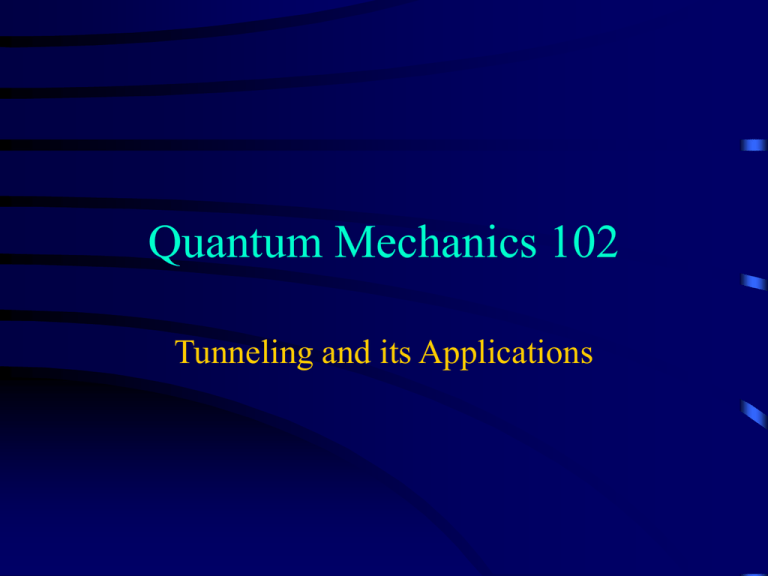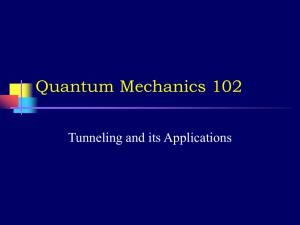Quantum Mechanics 102 Tunneling and its Applications
advertisement

Quantum Mechanics 102 Tunneling and its Applications Review • The probability of finding a particle in a particular region within a particular time interval is found by integrating the square of the wave function: • P (x,t) = |Y(x,t)|2 dx = |c(x)|2 dx • |c(x)|2 dx is called the “probability density; the area under a curve of probability density yields the probability the particle is in that region • When a measurement is made, we say the wave function “collapses” to a point, and a particle is detected at some particular location Particle in a box c(x) = B sin (npx/a) n=3 c(x) n=2 |c(x)|2 certain wavelengths l = 2a/n are allowed Only certain momenta p = h/l = hn/2a are allowed Only certain energies E = p2/2m = h2n2/8ma2 are allowed - energy is QUANTIZED Allowed energies depend on well width Only “Real-World” Wells • Solution has non-trivial form, but only certain states (integer n) are solutions • Each state has one allowed energy, so energy is again quantized • Energy depends on well width a (confinement width) |c(x)|2 n=2 n=1 x Putting Several Wells Together How do the electrons move between wells? Quantum wells • An electron is trapped since no empty energy states exist on either side of the well Escaping quantum wells • Classically, an electron could gain thermal energy and escape • For a deep well, this is not very probable. Given by Boltzmann factor. EB E A k BT Relative Probability e Escaping quantum wells • Thanks to quantum mechanics, an electron has a non-zero probability of appearing outside of the well • This happens much more often than thermal escape if the wells are close together. Energy Bands in Solids • Atomic energy levels become energy bands. What if free electron encounters barrier? Do Today’s Activity What Have You Seen? • What happens when electron energy is less than barrier height? • What happens when electron energy is greater than barrier height? • What affects tunneling probability? T e–2kL k = [8p2m(Epot – E)]½/h A classical diode • According to classical physics, to get to the holes on the other side of the junction, the conduction electrons must first gain enough energy to get to the conduction band on the p-side • This does not happen often once the energy barrier gets large • Applying a bias increases the current by decreasing the barrier A tunnel diode • According to quantum physics, electrons could tunnel through to holes on the other side of the junction with comparable energy to the electron • This happens fairly often • Applying a bias moves the electrons out of the p-side so more can tunnel in Negative resistance • As the bias is increased, however, the energy of the empty states in the p-side decreases • A tunneling electron would then end up in the band gap no allowed energy So as the potential difference is increased, the current actually decreases = negative R No more negative resistance • As bias continues to increase, it becomes easier for conduction electrons on the n-side to surmount the energy barrier with thermal energy • So resistance becomes positive again The tunneling transistor • Only electrons with energies equal to the energy state in the well will get through The tunneling transistor • As the potential difference increases, the energy levels on the positive side are lowered toward the electron’s energy • Once the energy state in the well equals the electron’s energy, the electron can go through, and the current increases. The tunneling transistor • The current through the transistor increases as each successive energy level reaches the electron’s energy, then decreases as the energy level sinks below the electron’s energy Quantum Entanglement (Quantum Computing) • Consider photons going through beam splitters • NO way to predict whether photon will be reflected or transmitted! (Color of line is NOT related to actual color of laser; all beams have same wavelength!) Randomness Revisited • If particle/probabilistic theory correct, half the intensity always arrives in top detector, half in bottom • BUT, can move mirror so no light in bottom! (Color of line is NOT related to actual color of laser; all beams have same wavelength!) Interference effects • Laser light taking different paths interferes, causing zero intensity at bottom detector • EVEN IF INTENSITY SO LOW THAT ONE PHOTON TRAVELS THROUGH AT A TIME • What happens if I detect path with bomb? No interference, even if bomb does not detonate! Interpretation • Wave theory does not explain why bomb detonates half the time • Particle probability theory does not explain why changing position of mirrors affects detection • Neither explains why presence of bomb destroys interference • Quantum theory explains both! – Amplitudes, not probabilities add - interference – Measurement yields probability, not amplitude - bomb detonates half the time – Once path determined, wavefunction reflects only that possibility presence of bomb destroys interference Quantum Theory meets Bomb • Four possible paths: RR and TT hit upper detector, TR and RT hit lower detector (R=reflected, T=transmitted) • Classically, 4 equally-likely paths, so prob of each is 1/4, so prob at each detector is 1/4 + 1/4 = 1/2 • Quantum mechanically, square of amplitudes must each be 1/4 (prob for particular path), but amplitudes can be imaginary or complex! – e.g., 1 1 1 i 1 i Y TR RT RR TT 2 2 2 2 2 2 Adding amplitudes 1 1 1 i 1 i Y TR RT RR TT 2 2 2 2 2 2 1 1 Y 0 2 2 2 • Lower detector: 2 1 i 1 i 2 2i • Upper detector: Y 1 2 2 2 2 2 2 2 2 2 What wave function would give 50% at each detector? Y a TR b RT c RR d TT • Must have |a| = |b| = |c| = |d| = 1/4 • Need |a + b|2 = |c+d|2 = 1/2 Y 1 2 2 TR 1 2 2 RT i 2 2 RR i 2 2 TT Use to determine if Bombs are any good • Roger Penrose, The Large, the Small and the Human Mind, CUP, pp.66-70 • R. Penrose, Shadows of the mind, Oxford University Press, Oxford. Before the Next Class • Do Activity 24 Evaluation before class Thursday (why not right now!) • Do Homework 25 • Reading Quiz 25 (Chapts. 9 and 10). • Exam on Monday, April 22. • Projects due Monday, April 29.







